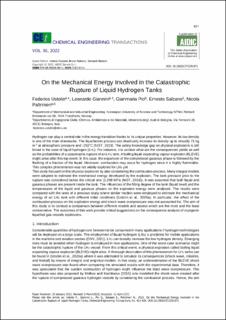| dc.contributor.author | Ustolin, Federico | |
| dc.contributor.author | Giannini, Leonardo | |
| dc.contributor.author | Pio, Gianmaria | |
| dc.contributor.author | Salzano, Ernesto | |
| dc.contributor.author | Paltrinieri, Nicola | |
| dc.date.accessioned | 2023-03-07T09:36:02Z | |
| dc.date.available | 2023-03-07T09:36:02Z | |
| dc.date.created | 2022-10-05T11:08:57Z | |
| dc.date.issued | 2022 | |
| dc.identifier.citation | Chemical Engineering Transactions. 2022, 91 421-426. | en_US |
| dc.identifier.issn | 1974-9791 | |
| dc.identifier.uri | https://hdl.handle.net/11250/3056341 | |
| dc.description.abstract | Hydrogen can play a central role in the energy transition thanks to its unique properties. However, its low density is one of the main drawbacks. The liquefaction process can drastically increase its density up to virtually 71 kg m-3 at atmospheric pressure and -253°C (NIST, 2019). The safety knowledge gap on physical explosions is still broad in the case of liquid hydrogen (LH2). For instance, it is unclear what are the consequences yields as well as the probabilities of a catastrophic rupture of an LH2 tank. A boiling liquid expanding vapour explosion (BLEVE) might arise after this top event. In this case, the expansion of the compressed gaseous phase is followed by the flashing of a fraction of the liquid. Moreover, combustion may occur for hydrogen since it is highly flammable. This complex phenomenon was not widely explored for LH2 yet.
This study focused on the physical explosion by also considering the combustion process. Many integral models were adopted to estimate the mechanical energy developed by the explosion. The tank pressure prior to the rupture was considered below the critical one (1.298 MPa (NIST, 2019)). It was assumed that both liquid and gaseous phases are present inside the tank. The influences of the filling degree of the tank (liquid level) and the temperatures of the liquid and gaseous phases on the explosion energy were analysed. The results were compared with the ones of a previous study where similar models were employed to estimate the mechanical energy of an LH2 tank with different initial conditions (Ustolin et al., 2020a). In particular, the effect of the combustion process on the explosion energy and shock wave overpressure was not accounted for. The aim of this study is to conduct a comparison between different models and assess which are the most and the least conservative. The outcomes of this work provide critical suggestions on the consequence analysis of cryogenic liquefied gas vessels explosions. | en_US |
| dc.language.iso | eng | en_US |
| dc.publisher | Italian Association of Chemical Engineering, AIDIC. | en_US |
| dc.title | On the Mechanical Energy Involved in the Catastrophic Rupture of Liquid Hydrogen Tanks | en_US |
| dc.title.alternative | On the Mechanical Energy Involved in the Catastrophic Rupture of Liquid Hydrogen Tanks | en_US |
| dc.type | Peer reviewed | en_US |
| dc.type | Journal article | en_US |
| dc.description.version | publishedVersion | en_US |
| dc.rights.holder | Copyright © 2022, AIDIC Servizi S.r.l. | en_US |
| dc.source.pagenumber | 421-426 | en_US |
| dc.source.volume | 91 | en_US |
| dc.source.journal | Chemical Engineering Transactions | en_US |
| dc.identifier.doi | 10.3303/CET2291071 | |
| dc.identifier.cristin | 2058711 | |
| dc.relation.project | Norges forskningsråd: 280964 | en_US |
| cristin.ispublished | true | |
| cristin.fulltext | original | |
| cristin.qualitycode | 1 | |
